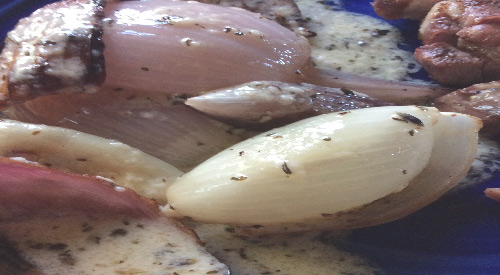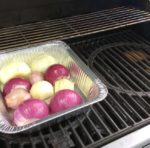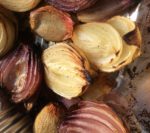 |
| Caution- When selecting wood chips for smoking know the wood source! |
If you’ve ever looked at the wood chips for smoking products available at most discount retail stores, you’ll notice that they seem to have consistent pricing in the $3.99 or less bracket. Yet, you look at the SmokinLicious® brand and come up with a price that’s close to twice the cost. What’s the deal with the price difference?
There are many factors involved in determining the retail price of wood chips many of which I’m sure the average consumer hasn’t considered. What exactly are you paying for when you select a specific wood chip brand?
Let me give you some insight.
Let’s Start with the Raw Material
The raw material is by far the largest cost factor with selling wood chips for grilling, smoking, and cooking in general. I’ll make the comparison to cotton purchased by a t-shirt manufacturer. There are grades of cotton. Higher grades of cotton go into more expensive cotton clothing. Purchase a $5 t-shirt and you’re guaranteed a lower grade cotton was used. This means you likely won’t get more than a year of consistent wearing and washing out of that $5 t-shirt!The same is true for wood chips. There are 8 different grades of wood or lumber for purposes such as cabinet making, flooring, construction, and pallets. Only one culinary wood company specifically purchases raw lumber material for cooking wood manufacture only. That would be SmokinLicious®.
Other companies will do one of three things; have a primary business in one of the areas listed above and use the waste product for producing the wood chips, or, purchase another company’s waste product to market as a wood chip grilling and smoking wood, or, have the company with waste product package a private label brand of grilling and smoking chips and deliver to a centralized distribution warehouse for the brand, something commonly done by equipment manufacturers who feel a need to offer a wood chip to go with the equipment.
Cleanliness of the Manufacturing Process
Another key factor in cost is the handling of the material during the manufacturing process. Now I understand that we are talking about wood and not a food item. However, if you are using a wood to add flavoring to food through smoke vapor from burning wood, then I see the wood as an ingredient. As with any ingredient, I would prefer to use something that is clean and pure since I will be eating this.Since I’ve already pointed out that many companies use materials that are labeled as waste wood, you have no idea how the waste material was collected, stored, moved, and processed. You also don’t know what’s in that waste wood (treated lumber pieces, a mix of woods, some softwoods) or how old that material is which directly affects the moisture level. Remember, moisture is needed to smolder the wood and produce smoke vapor.
SmokinLicious® is the only culinary wood manufacturer that is Kosher certified, attesting to the steps taken to ensure the culinary products are clean, clean stored, and preserved.
Varieties and Availability
One means of keeping cost down is to offer chips that have not been debarked, have not had any mold spores removed, or for that matter dirt and debris. The entire log piece may be placed in a grinding unit which will generate an assortment of chip sizes as well as the dust that comes with this single equipment use. Honestly, you can’t be sure you are getting 100% of the wood listed on the package when these locations are generating extreme volumes of rough grind chip product. The company may simply call it a hardwood chip and not state what hardwood is in the mix. Remember, only specific hardwoods should be used in grilling and smoking.Of course, the variety of wood also can increase the cost. Remember, there are many uses for a wood including the export demand to other countries outside of North America. As with any commodity, higher demands translate to higher cost. Hickory is one of those hardwoods that has become very expensive in the market as the wood is used for railroad ties, utility company pavers to get into mountain ranges, and heavily purchased by the Asian market for a purpose that is not clear.
Cost of Manufacturing
Both the labor involved making the chip product and the location that the chips are manufactured in play a role in determining the cost of the final product. Again, if the chip product is the result of another manufacturing level of the wood like making cabinets, then by using the scrap wood for the “chip” product, the overall cost of the chip product will be lower as labor and manufacturing costs can be covered by the initial cabinet making.If, however, there is no other manufacturing purpose for the wood other than a wood chip production, all manufacturing costs are directed to that chip product. Then there is the question of where the chips are manufactured. Here are some minimum wage costs by the state that will certainly play a role in the final product cost: New York State $10.40, New Jersey $8.60, Texas $7.25, Florida $8.25, Wisconsin $7.25, Michigan $9.25.
Other costs that factor in include: how the chips are packaged, the moisture level of the product which directly determines the weight, how the wood is treated for both drying and for pest control, and if there is a screening of the chips to remove wood dust and make the chips more uniform.
SmokinLicious® developed over a 3-year period a specialized screen process which allows us to offer 7 different grind levels of wood chips, all bark-free, all from the heartwood of the hardwood only, and all dust free.
Perhaps it’s time you take a closer look at that package of $3.99 wood chips and see where it is manufactured, who manufactures it, what the contents of the bag include, and what weight there is to the product. Now that you’re educated on how to assess the value of your next wood chip purchase, the choice will be up to you.












